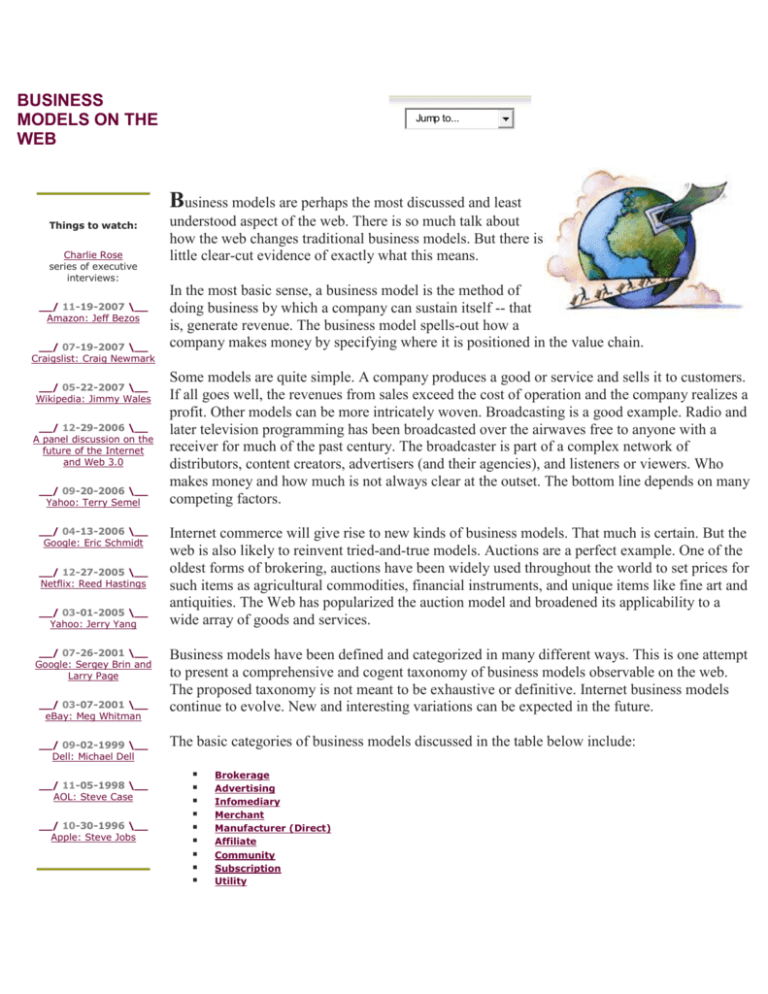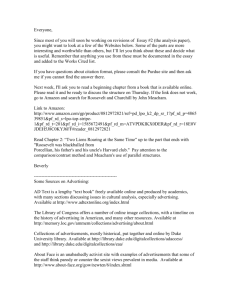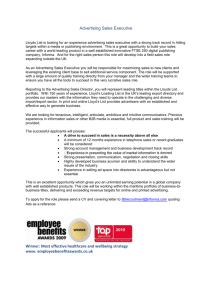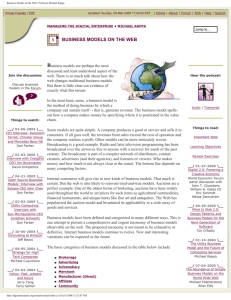Distribution BUSINESS MODELS ON THE WEB
advertisement

BUSINESS MODELS ON THE WEB Jump to... Business models are perhaps the most discussed and least Things to watch: Charlie Rose series of executive interviews: __/ 11-19-2007 \__ Amazon: Jeff Bezos __/ 07-19-2007 \__ Craigslist: Craig Newmark __/ 05-22-2007 \__ Wikipedia: Jimmy Wales __/ 12-29-2006 \__ A panel discussion on the future of the Internet and Web 3.0 __/ 09-20-2006 \__ Yahoo: Terry Semel __/ 04-13-2006 \__ Google: Eric Schmidt __/ 12-27-2005 \__ Netflix: Reed Hastings __/ 03-01-2005 \__ Yahoo: Jerry Yang __/ 07-26-2001 \__ Google: Sergey Brin and Larry Page __/ 03-07-2001 \__ eBay: Meg Whitman __/ 09-02-1999 \__ Dell: Michael Dell __/ 11-05-1998 \__ AOL: Steve Case __/ 10-30-1996 \__ Apple: Steve Jobs understood aspect of the web. There is so much talk about how the web changes traditional business models. But there is little clear-cut evidence of exactly what this means. In the most basic sense, a business model is the method of doing business by which a company can sustain itself -- that is, generate revenue. The business model spells-out how a company makes money by specifying where it is positioned in the value chain. Some models are quite simple. A company produces a good or service and sells it to customers. If all goes well, the revenues from sales exceed the cost of operation and the company realizes a profit. Other models can be more intricately woven. Broadcasting is a good example. Radio and later television programming has been broadcasted over the airwaves free to anyone with a receiver for much of the past century. The broadcaster is part of a complex network of distributors, content creators, advertisers (and their agencies), and listeners or viewers. Who makes money and how much is not always clear at the outset. The bottom line depends on many competing factors. Internet commerce will give rise to new kinds of business models. That much is certain. But the web is also likely to reinvent tried-and-true models. Auctions are a perfect example. One of the oldest forms of brokering, auctions have been widely used throughout the world to set prices for such items as agricultural commodities, financial instruments, and unique items like fine art and antiquities. The Web has popularized the auction model and broadened its applicability to a wide array of goods and services. Business models have been defined and categorized in many different ways. This is one attempt to present a comprehensive and cogent taxonomy of business models observable on the web. The proposed taxonomy is not meant to be exhaustive or definitive. Internet business models continue to evolve. New and interesting variations can be expected in the future. The basic categories of business models discussed in the table below include: Brokerage Advertising Infomediary Merchant Manufacturer (Direct) Affiliate Community Subscription Utility __/ 01-27-2007 \__ The Impact of Web 2.0 and Emerging Social Network Models World Economic Forum __/ 09-27-2006 \__ Web-scale Computing Services at Amazon.com Jeff Bezos __/ 05-17-2006 \__ Users, Not Money: the Google Business Model Marissa Mayer __/ 01-27-2006 \__ Digital 2.0: Powering a Creative Economy World Economic Forum __/ 06-05-2004 \__ Strategy for High Tech Companies Michael Cusumano __/ 09-26-2002 \__ A Conversation with Michael Dell __/ 05-01-2002 \__ How Does Google Actually Make Money? Larry Page Case studies: Amazon.com America Online ChemConnect Classmates Coolsavings Counterpane Craigslist Dell Computer DoubleClick eBay Flickr Google iTunes Lands' End Listen.com LiveWire Monster.com Netflix New York Times Orbitz Overture PayPal Priceline Red Hat Slashdot Truste The models are implemented in a variety of ways, as described below with examples. Moreover, a firm may combine several different models as part of its overall Internet business strategy. For example, it is not uncommon for content driven businesses to blend advertising with a subscription model. Business models have taken on greater importance recently as a form of intellectual property that can be protected with a patent. Indeed, business models (or more broadly speaking, "business methods") have fallen increasingly within the realm of patent law. A number of business method patents relevant to e-commerce have been granted. But what is new and novel as a business model is not always clear. Some of the more noteworthy patents may be challenged in the courts. Type of Model: Description: Brokerage Model Brokers are market-makers: they bring buyers and sellers together and facilitate transactions. Brokers play a frequent role in businessto-business (B2B), business-to-consumer (B2C), or consumer-toconsumer (C2C) markets. Usually a broker charges a fee or commission for each transaction it enables. The formula for fees can vary. Brokerage models include: Marketplace Exchange -- offers a full range of services covering the transaction process, from market assessment to negotiation and fulfillment. Exchanges operate independently or are backed by an industry consortium. [Orbitz, ChemConnect] Buy/Sell Fulfillment -- takes customer orders to buy or sell a product or service, including terms like price and delivery. [CarsDirect, Respond.com] Demand Collection System -- the patented "name-your-price" model pioneered by Priceline.com. Prospective buyer makes a final (binding) bid for a specified good or service, and the broker arranges fulfillment. [Priceline.com] Auction Broker -- conducts auctions for sellers (individuals or merchants). Broker charges the seller a listing fee and commission scaled with the value of the transaction. Auctions vary widely in terms of the offering and bidding rules. [eBay] Transaction Broker -- provides a third-party payment mechanism for buyers and sellers to settle a transaction. [PayPal, Escrow.com] Distributor -- is a catalog operation that connects a large number of product manufacturers with volume and retail buyers. Broker facilitates business transactions between franchised distributors and their trading partners. Search Agent -- a software agent or "robot" used to search-out the price and availability for a good or service specified by the buyer, or to locate hard to find information. Virtual Marketplace -- or virtual mall, a hosting service for online merchants that charges setup, monthly listing, and/or transaction fees. May also provide automated transaction and relationship marketing services. [zShops and Merchant Services at Wikipedia Yahoo! Amazon.com] return to top Hungry minds: Advertising Model The Long Tail Chris Anderson iTunes: How Copyright, Contract, and Technology Shape the Business of Digital Media William W. Fisher, et al. The web advertising model is an extension of the traditional media broadcast model. The broadcaster, in this case, a web site, provides content (usually, but not necessarily, for free) and services (like email, IM, blogs) mixed with advertising messages in the form of banner ads. The banner ads may be the major or sole source of revenue for the broadcaster. The broadcaster may be a content creator or a distributor of content created elsewhere. The advertising model works best when the volume of viewer traffic is large or highly specialized. Portal -- usually a search engine that may include varied content or services. A high volume of user traffic makes advertising profitable and permits further diversification of site services. A personalized portal allows customization of the interface and content to the user. A niche portal cultivates a well-defined user demographic. [Yahoo!] An e-Business Model Ontology for Modeling e-Business Alexander Osterwalder Yves Pigneur Classifieds -- list items for sale or wanted for purchase. Listing fees are common, but there also may be a membership fee. [Monster.com, Craigslist] User Registration -- content-based sites that are free to access but require users to register and provide demographic data. Registration allows inter-session tracking of user surfing habits and thereby generates data of potential value in targeted advertising campaigns. [NYTimes] The Truth about Internet Business Models Jeffrey F. Rayport B2B E-Commerce Hubs Steven Kaplan Mohanbir Sawhney Query-based Paid Placement -- sells favorable link positioning (i.e., sponsored links) or advertising keyed to particular search terms in a user query, such as Overture's trademark "pay-for-performance" model. [Google, Overture] Business Models for Electronic Markets Paul Timmers Contextual Advertising / Behavioral Marketing -- freeware developers who bundle adware with their product. For example, a browser extension that automates authentication and form fill-ins, also delivers advertising links or pop-ups as the user surfs the web. Contextual advertisers can sell targeted advertising based on an individual user's surfing activity. A Taxonomy of Internet Commerce Paul Bambury Content-Targeted Advertising -- pioneered by Google, it extends the precision of search advertising to the rest of the web. Google identifies the meaning of a web page and then automatically delivers relevant ads when a user visits that page. [Google] Previous topic: Intromercials -- animated full-screen ads placed at the entry of a site before a user reaches the intended content. [CBS MarketWatch] Ultramercials -- interactive online ads that require the user to respond intermittently in order to wade through the message before reaching the intended content. [Salon in cooperation with MercedesBenz] Web Analytics return to top Infomediary Model Data about consumers and their consumption habits are valuable, especially when that information is carefully analyzed and used to target marketing campaigns. Independently collected data about producers and their products are useful to consumers when considering a purchase. Some firms function as infomediaries (information intermediaries) assisting buyers and/or sellers understand a given market. Advertising Networks -- feed banner ads to a network of member sites, thereby enabling advertisers to deploy large marketing campaigns. Ad networks collect data about web users that can be used to analyze marketing effectiveness. [DoubleClick] Audience Measurement Services -- online audience market research agencies. [Nielsen//Netratings] Incentive Marketing -- customer loyalty program that provides incentives to customers such as redeemable points or coupons for making purchases from associated retailers. Data collected about users is sold for targeted advertising. [Coolsavings] Metamediary -- facilitates transactions between buyer and sellers by providing comprehensive information and ancillary services, without being involved in the actual exchange of goods or services between the parties. [Edmunds] return to top Merchant Model Wholesalers and retailers of goods and services. Sales may be made based on list prices or through auction. Virtual Merchant --or e-tailer, is a retail merchant that operates solely over the web. [Amazon.com] Catalog Merchant -- mail-order business with a web-based catalog. Combines mail, telephone and online ordering. [Lands' End] Click and Mortar -- traditional brick-and-mortar retail establishment with web storefront. [Barnes & Noble] Bit Vendor -- a merchant that deals strictly in digital products and services and, in its purest form, conducts both sales and distribution over the web. [Apple iTunes Music Store] return to top Manufacturer (Direct) Model The manufacturer or "direct model", it is predicated on the power of the web to allow a manufacturer (i.e., a company that creates a product or service) to reach buyers directly and thereby compress the distribution channel. The manufacturer model can be based on efficiency, improved customer service, and a better understanding of customer preferences. [Dell Computer] Purchase -- the sale of a product in which the right of ownership is transferred to the buyer. Lease -- in exchange for a rental fee, the buyer receives the right to use the product under a “terms of use” agreement. The product is returned to the seller upon expiration or default of the lease agreement. One type of agreement may include a right of purchase upon expiration of the lease. License -- the sale of a product that involves only the transfer of usage rights to the buyer, in accordance with a “terms of use” agreement. Ownership rights remain with the manufacturer (e.g., with software licensing). Brand Integrated Content -- in contrast to the sponsored-content approach (i.e., the advertising model), brand-integrated content is created by the manufacturer itself for the sole basis of product placement. return to top Affiliate Model In contrast to the generalized portal, which seeks to drive a high volume of traffic to one site, the affiliate model, provides purchase opportunities wherever people may be surfing. It does this by offering financial incentives (in the form of a percentage of revenue) to affiliated partner sites. The affiliates provide purchase-point clickthrough to the merchant. It is a pay-for-performance model -- if an affiliate does not generate sales, it represents no cost to the merchant. The affiliate model is inherently well-suited to the web, which explains its popularity. Variations include, banner exchange, pay-per-click, and revenue sharing programs. [Barnes & Noble, Amazon.com] Banner Exchange -- trades banner placement among a network of affiliated sites. Pay-per-click -- site that pays affiliates for a user click-through. Revenue Sharing -- offers a percent-of-sale commission based on a user click-through in which the user subsequently purchases a product. return to top Community Model The viability of the community model is based on user loyalty. Users have a high investment in both time and emotion. Revenue can be based on the sale of ancillary products and services or voluntary contributions; or revenue may be tied to contextual advertising and subscriptions for premium services. The Internet is inherently suited to community business models and today this is one of the more fertile areas of development, as seen in rise of social networking. Open Source -- software developed collaboratively by a global community of programmers who share code openly. Instead of licensing code for a fee, open source relies on revenue generated from related services like systems integration, product support, tutorials and user documentation. [Red Hat] Open Content -- openly accessible content developed collaboratively by a global community of contributors who work voluntarily. [Wikipedia] Public Broadcasting -- user-supported model used by not-for-profit radio and television broadcasting extended to the web. A community of users support the site through voluntary donations. [The Classical Station (WCPE.org)] Social Networking Services -- sites that provide individuals with the ability to connect to other individuals along a defined common interest (professional, hobby, romance). Social networking services can provide opportunities for contextual advertising and subscriptions for premium services. [Flickr, Friendster, Orkut] return to top Subscription Model Users are charged a periodic -- daily, monthly or annual -- fee to subscribe to a service. It is not uncommon for sites to combine free content with "premium" (i.e., subscriber- or member-only) content. Subscription fees are incurred irrespective of actual usage rates. Subscription and advertising models are frequently combined. Content Services -- provide text, audio, or video content to users who subscribe for a fee to gain access to the service. [Listen.com, Netflix] Person-to-Person Networking Services -- are conduits for the distribution of user-submitted information, such as individuals searching for former schoolmates. [Classmates] Trust Services -- come in the form of membership associations that abide by an explicit code of conduct, and in which members pay a subscription fee. [Truste] Internet Services Providers -- offer network connectivity and related services on a monthly subscription. [America Online] return to top Utility Model The utility or "on-demand" model is based on metering usage, or a "pay as you go" approach. Unlike subscriber services, metered services are based on actual usage rates. Traditionally, metering has been used for essential services (e.g., electricity water, long-distance telephone services). Internet service providers (ISPs) in some parts of the world operate as utilities, charging customers for connection minutes, as opposed to the subscriber model common in the U.S. Metered Usage -- measures and bills users based on actual usage of a service. Metered Subscriptions -- allows subscribers to purchase access to content in metered portions (e.g., numbers of pages viewed). [Slashdot] return to top About the author: Michael Rappa is director of the Institute for Advanced Analytics at North Carolina State University









